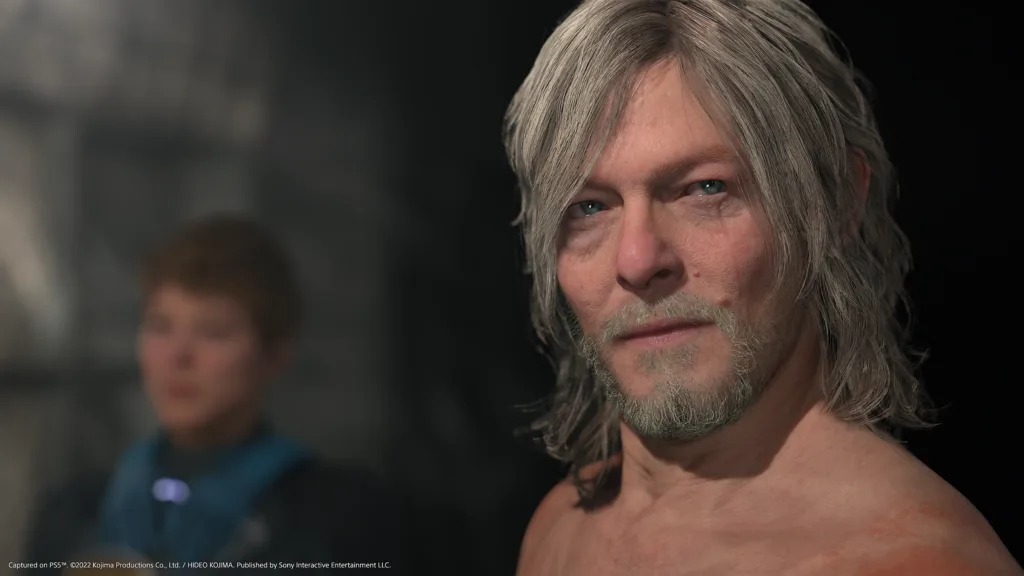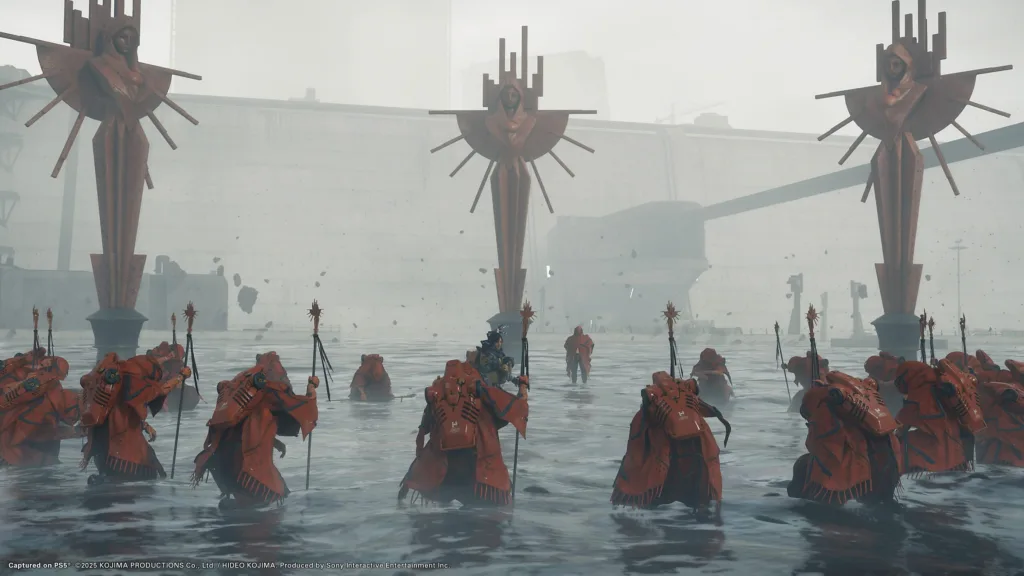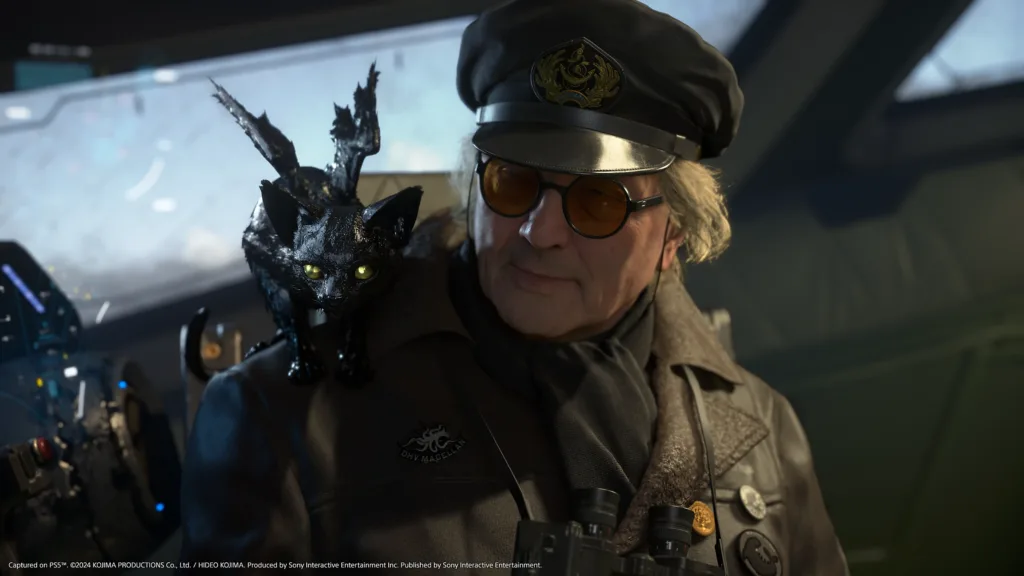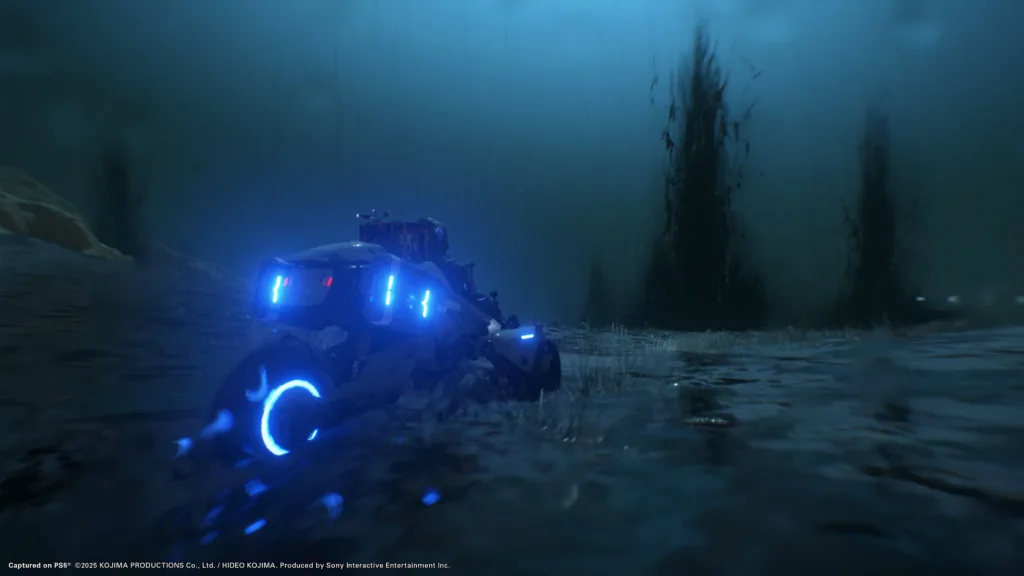Death Stranding 2: On the Beach arrives as Hideo Kojima’s most confident work in years, transforming the experimental foundation of its predecessor into something that feels both familiar and revolutionary. The game thrusts Sam Porter Bridges back into the remains of civilization eleven months after the first game’s finale.
Now living in rural Mexico with toddler Lou, Sam is drawn out of retirement when Fragile recruits him for an audacious contract: extend the Chiral Network from Central America across Australia, stitching together isolated settlements before the next extinction pulse hits.
Hideo Kojima’s sequel keeps the strand-type ethos intact—half logistical simulator, half stealth-action sandbox—yet expands its scale through harsher biomes, dynamic weather that reshapes rivers in real time, and an asynchronous online layer where players co-author infrastructure.
The design speaks to individual resilience filtered through communal support: every ladder, monorail segment, or zip-line dropped by another courier can shave hours off a trek, turning solitude into camaraderie. Cinematic flair, absurdist gadgetry, and panoramic vistas underline an ambition matched by few open-world projects, setting the stage for a tale that balances personal grief against planetary stakes.
Circuitry of Bonds and Badlands
Sam Porter Bridges starts Death Stranding 2 on a sun-bleached ridge in Baja California, Lou toddling in the dust behind him. Domestic calm lasts a single heartbeat before Fragile lands her VTOL and pitches an audacious contract: thread the Chiral Network from Mexico to Australia, flip the Plate Gate, and keep a second extinction event at bay.
Acceptance drops Sam onto the DHV Magellan—part freighter, part mobile safe-house—whose corridors expand or shrink as Drawbridge’s resources ebb with player choices. Every decision in the cargo manifest, from allotting polymer crates to hoarding blood packs, reshapes available rooms and unlocks fresh dialogue lines, echoing the environmental storytelling tricks of Citizen Sleeper and Sunless Sea while never burying newcomers under stat screens.
Character writing benefits from Kojima’s maximalism yet keeps a clear through-line. Dialogue wheels aren’t sprawling Bioware trees; they’re sharp inflection points where Sam’s tone—gruff, hopeful, bitter—nudges relationships. Offer a curt reply to Rainy after a punishing sandstorm and her next weather forecast arrives late, exposing you to unannounced timefall. Show empathy and she tags BT clusters ahead of schedule, smoothing the trek. Rewards stay grounded—no branching endings—but they lend emotional cause-and-effect to a world otherwise ruled by algorithmic terrain. It recalls the confidence of Disco Elysium: small verbal pivots that leave lasting fingerprints without derailing the main plot.
Higgs returns, wielding a crimson guitar that modulates reality like an amphetamine-fueled theremin, a theatrical foil who frames Sam’s stoicism by going full glam-punk. Neil, meanwhile, feels ripped from an unmade Metal Gear: hushed radio calls, tragic dossier, and a scar that never quite heals. Their presence plays off Fragile’s evolving leadership; her glove-scarf loadout doubles as both visual flourish and stealth mechanic, letting her ghost across arenas during assist segments if players invest in Drawbridge morale. The result is a cast whose gimmicks fuse with mechanical hooks—Tarman’s tar-compass reorients the mini-map through subterranean currents, Dollman’s stop-motion reconnaissance drone opens sniper perches—mirroring the modular companions found in Into the Breach where personality equals utility.
Themes hit with blunt sincerity. Connection versus isolation lands through the asynchronous online layer, but the script adds fresh barbs: environmental backlash spills literal oceans of tar; AI-generated art posters litter safe-rooms, mocking creative labor; grief surfaces whenever Lou mimics Sam’s absent handshake. Recurring imagery—oil slicks, aging rain, a colossal moon hanging too low—feels overt, yet mechanics reinforce it.
Building a monorail in flood-plain zones lifts cargo above rising rivers, a mechanical answer to climate dread. Sharing that structure rewards both you and unseen couriers with likes, a dopamine drip that critiques the same social metrics it employs. Few narrative-driven titles, indie or triple-A, fold theme and system together with such conviction—Kentucky Route Zero explores capitalism through stagecraft, but it never lets the audience lay track across its world.
Story pacing tracks an expanding spiral: a brisk tutorial through Mexican canyons, a mid-game stretch of cross-continental delivery punctuated by boss arenas, then a finale that leaps from cosmic horror to tender lullaby without slowing. Early hours feel dense with exposition, though the Corpus glossary patches in context on demand, sparing players from Wikipedia dives. Motion-capture cut-scenes linger on micro-expressions—Neil’s jaw set before an apology, Rainy’s involuntary shiver at open sky—while fourth-wall gags tilt expectations, including one sequence that hijacks the DualSense speaker with Dollman’s warped lullaby until you physically detach Lou’s pod.
For all its auteur flourishes, the narrative succeeds because it respects mechanical cadence. Long hauls across desert plateaus are scored by Low Roar guitar strums timed to footfalls, granting space for reflection before the next plot spike. Combat-heavy chapters shorten delivery distances, preventing emotional fatigue even on repeat failure. It’s a rhythm more akin to Hades than a conventional open-world sprawl: tension, release, character beat, upgrade, repeat.
The loop keeps both casual couriers and spreadsheet-minded porters invested, and the story’s bigger questions—what defines connection, who pays the bill—land harder for that interdependence. The trek is arduous, yet every rope bridge, every patched-in monorail pillar feels like a personal stanza in Kojima’s sprawling poem, written one crate at a time.
Parcels, Plateaus, and Player Agency
Preparing for a haul across post-collapse Australia feels closer to laying out a Dwarf Fortress expedition than ticking boxes in a loot shooter. Each order begins on the map table inside the DHV Magellan: timefall radar sweeps the region, BT density blooms in red blots, and wind arrows hint at sandstorms hours away. Deciding whether to sprint through a weather window or detour around it feeds straight back into story texture—arrive early and a settlement chief greets Sam with relief, turning a one-line NPC into a short cut-scene; miss the window, and the same character meets you over comms, voice trembling while describing damage you might have prevented. Those conversational ripples may not split the narrative path, yet they color every kilometre that follows, giving weight to what is otherwise a logistics puzzle.
On paper the toolset echoes the first game—ladders, climbing anchors, container repairs—but early access to a coffin-shaped hoverboard and the much-talked-about blood boomerang nudges even timid couriers toward experimentation. I sling the boomerang exactly once during an entire night run, yet its presence shapes the route planning phase: a light weapon frees up weight for extra ladders, which in turn opens a shortcut up a basalt cliff, trimming half an hour off delivery time. The loop recalls the decision layers in Into the Breach, where a single gadget reshapes the tactics of a whole encounter.
Moment-to-moment traversal still hinges on balance physics. Every crate stacks with visible wobble, and dual-trigger grip keeps Sam upright while draining stamina. That tactile stress stands in sharp contrast to open-world fast-travel norms—think of how The Witcher 3 or Elden Ring let the map melt beneath a mount. Here, a two-degree tilt on wet shale feels dramatic because a mistimed footfall can send rare medicines down a ravine and spike your reputation meter in reverse. Exoskeleton upgrades soften the sting, yet choosing the heavier power legs reduces battery life for the BT scanner, turning an equipment swap into a narrative gamble: better footing at the cost of reduced ghost vision. Few modern RPGs—Pathologic 2 springs to mind—tie encumbrance so directly to emotional tension.
Environmental threats have multiplied in ways that read like commentary on climate backlash. Rising rivers swallow ramps you built minutes earlier, while quake fissures can erase a zip-line anchor planted by another player. These dynamic shifts make cooperative infrastructure feel alive; your highway segment might exist for days, then vanish in a single server refresh, leaving a hollow where dozens of players once traded Likes. It’s a system mirrored in smaller form by indie survival title Rain World, though Kojima’s crew applies the concept at continent scale.
Vehicles now arrive shockingly early. The off-roader’s auto-pickup arm catches stray cargo like Katamari on asphalt, turning what could be busywork into a meditative cruise. Yet the truck’s bulk limits cliff routes and attracts MULE radar pings, so there’s a push-pull tension: save stamina or stay stealthy? The game never chastises a reckless driver, but repair bills eat into Drawbridge’s shared resource pool—burn through ceramic and you’ll delay another player’s monorail project, an asynchronous consequence more persuasive than any morality bar.
Speaking of infrastructure, the new monorail feels like a macro-level counterpart to Terraria’s minecart systems. Laying track demands absurd material stockpiles, yet each completed leg instantly shortens future supply chains. Watching the first cargo capsule glide above a BT-infested valley delivers a narrative payoff as strong as any cut-scene: a silent promise that humanity can still create grand works. Contrast this with the coffin surfboard—a delightfully silly gadget that turns sheer dunes into half-pipe playgrounds, but at the cost of traction if a sandstorm cuts visibility. The design team clearly wants players to oscillate between power fantasy and hard-scrabble endurance, matching the story’s oscillation between cosmic bombast and quiet grief.
Mission templates push that duality further. Core orders stick to life-support essentials; side gigs drift toward Kojima-brand absurdism, from rescuing a lost kangaroo to serving a VTuber her weekly pizza. These tonal whiplashes could feel disjointed, yet the star-rank reward ladder stitches them together. Deliver a novelty item flawlessly and Sam earns new chip slots—maybe an ankle stabilizer for platforming, maybe a like-multiplying social module—that feed back into earnest medical missions. It’s the same carrot that makes Spiritfarer’s ferry chores resonate: trifling tasks gain purpose when they unlock tools for heavier narrative beats.
Character progression lives in a plug-in grid that smartly dodges the bloat seen in many AAA skill trees. Slots are limited, forcing hard choices: equip the quiet-step stealth mod or the humidity sensor? The game tracks performance in the background, nudging perks that align with your habits, so a run-and-gun porter sees recoil dampeners appear first while a pathfinder earns extended ladder range. The adaptive feed feels akin to Hades’ mirror of night, nudging players toward fresh builds without forcing respec menus. It also ties back to story tone—Dollman quips about your playstyle in private-room interludes, turning what could be stat crunch into character banter.
Quality-of-life refinements shave off much of the original’s rough prep work: tool fabrication is faster, weight presets auto-stack by type, and the scanner now pings ladders through fog. Yet the inventory carousel still buries key items behind too many radial layers—a friction point that surfaces whenever a river overtops its bank and you fumble for a rope while crates swirl downstream. Irritation aside, that clumsiness aligns with the fiction; Sam isn’t a superhero shifting gear via mind-palace but a trucker rifling through boxes in a storm.
Taken together, these systems create a feedback lattice where every terrain crest, every toolbox tweak, and every goodwill gesture from another courier reverberates through both play and plot. The result doesn’t chase sleek genre peers like Horizon or Ghost of Tsushima; it sits closer to the patient, systems-first ethos of SnowRunner, yet with a beating narrative heart. The wasteland asks you to plan, improvise, and occasionally surf a coffin down a dune—and somehow every crate you haul picks up narrative dirt along the way.
Quiet Gunfire, Loud Intent
Hideo Kojima’s approach to conflict still pivots on the idea that every bullet is a moral choice. In Death Stranding 2 a lethal shot doesn’t just remove a foe; it triggers a voidout that leaves a glassy crater on the shared map, permanently rewriting traversal lines for everyone on the server. That single rule turns firefights into puzzles of restraint. On the surface you wield a familiar action-stealth kit—tranq sniper, rubber-slug shotgun, blood grenades—but the real ammunition is intent. Opt for non-lethal tools and the landscape remains passable, settlements keep their hard-won infrastructure, and Sam’s reputation climbs. Reach for live rounds and the terrain answers with a smoking scar, erasing zip-lines and highways in a way that feels pointedly harsher than Metal Gear Solid V’s bloody headband penalty or the reputation swings in Fallout: New Vegas.
The armoury encourages invention rather than escalation. The blood boomerang arcs out like a grotesque frisbee, stunning BTs without piercing the skin. A lock-on chip lets the multi-grenade launcher sweep marauder camps in one fluid motion, yet its weight slows Sam’s balance meter, pressing players to weigh firepower against footing. My favourite contraption, the homing-missile robot dog, calls back to indie curiosity Bad North: you tag targets with binoculars, then watch the pup dash off, silently neutralising guards before circling back for a head pat. Each gadget plugs into the same resource economy that powers bridges and monorails, so choosing heavy ordnance might delay a community road project. Combat decisions ripple into civic progress, and those ripples feel far stronger than a binary karma bar.
Stealth leans on tactile improvisation rather than scripted routes. Tall grass masks Sam’s outline, yet the real MVP is the footprint scrubber, a heel-mounted bristle that erases tracks with every crouch step. Pair it with the Dollman drone, which floats overhead spotting patrol patterns, and encounters turn into mini sand-table exercises reminiscent of Invisible, Inc.. A hologram decoy can lure cyborg squads away, but it drains chiral bandwidth—the same stat that powers your BT scanner—so every distraction is another small gamble against the supernatural storm front rolling in. Victory rarely hinges on memorising patrol cycles; it hinges on reading the environment’s competing meters and tweaking load-outs to fit.
Enemy variety backs that flexibility. Standard marauders come in armour tiers that direct you toward mix-and-match ammo, while cyborg units resist tranq darts unless you first hack their visors with a coil pistol. BT classes escalate from wraithlike sprinters to tar-swimming leviathans that can yank vehicles underground. Signature bosses punctuate chapters with theatrical flair: an early tentacle mech twirls cargo crates like nunchaku; Higgs reappears in guitar-propelled ambushes that feel part bullet hell, part road-trip hallucination; Neil’s duels drape molten neon across brutalist ruins, pushing the lock-on system to its limit. These set pieces marry mechanics and story without losing player agency—skip options exist for accessibility, yet tackling them head-on rewards permanent chip slots and fresh traversal perks.
Moment-to-moment feel strikes a measured balance. Critical hits trigger a short slow-motion bloom that signals success without shredding pacing, a flourish closer to Red Dead Redemption 2’s Dead Eye than a conventional quick-time event. Vehicle hijacks add a splash of Mad Max energy: stun the driver, vault in, spin the turret on pursuing bikes. On normal difficulty the curve flatters improvisation; late acts tighten enemy AI and introduce weather modifiers that rust exoskeleton joints, nudging veterans toward the skill tree’s specialist branches—quiet operator for heavier stealth bonuses, fire-support specialist for tighter spread on the grenade launcher, weather analyst for longer safe windows under timefall.
Character growth refrains from bloat. Chips live in a finite grid, so a sniper-friendly pipeline of breath-control upgrades might push out the sensor that reveals hidden handholds. The constraint echoes Into the Breach’s limited pilot slots: power spikes feel earned because sacrifice is always part of the equation. The design team also watches player behaviour under the hood, presenting new chips that reflect recent habits. Spend an hour driving over dunes and the next loot crate is likely to hold a sand-traction mod; ghost-hunt in the rain and you’ll see enhanced BT radar first. Progression feels conversational—an ongoing negotiation between play style and narrative framing—rather than a treadmill of incremental buffs.
The end result is combat that threads personal ethics through tactile systems without slipping into lecture mode. Every stun dart, every erased footprint, every crater left smoking on the horizon feeds back into Sam’s emotional arc: a courier asked to connect the world while deciding how much collateral damage that connection is worth. Few triple-A games outside immortals like Deus Ex place that moral weight so squarely on mechanical shoulders, and fewer still manage to keep the shootouts fun while doing it.
Pixels, Pulse, Performance
Australian badlands slide from ochre dunes into glacial ridges without a loading bar in sight. The Decima engine paints every biome with photogrammetry sharp enough to count sediment layers, yet Kojima Productions resists postcard composition; storms roll in, flood-plains swell, and that swollen moon hangs low enough to bleach shadows from the desert floor. Switching from high noon glare to midnight timefall shows no grit shimmer or dithering, a feat that recalls Horizon Forbidden West’s best vistas while surpassing it in draw-distance density. Even the tar—so plentiful it should look repetitive—carries subtle viscosity changes under different light angles, giving the black pools an oily depth that feels interactive rather than decorative.
Character craft keeps pace. Yoji Shinkawa sculpts Higgs into a glam-ghoul rock star—all brass filigree and heat-stained chrome—while Fragile sports high-fashion techwear that flutters against simulated gusts. Sam’s mud-caked poncho gains new tears after each slide down basalt scree, and BT tendrils leave shimmering imprints that fade with the next gust, small touches that make wear-and-tear feel diegetic. Creature work leans heavier on horror this time: tar leviathans gleam under ray-traced reflections, their surfaces shifting like living obsidian, calling to mind the liquid metal illusions in Control but rendered at blockbuster scale.
PlayStation 5 performance mode locks at 60 frames per second during traversal, firefights, and those lengthy one-take cut-scenes that stretch into minutes. Resolution drops to dynamic 1440p under heavy volumetric fog, yet texture fidelity stays intact, avoiding the blurred foliage that plagues many console open worlds. Short bursts in quality mode deliver 4K fidelity with ray-traced shadows and reflections, trading some responsiveness for screenshot nirvana. Loading is a blink-and-miss affair—seven seconds from dashboard to Sam’s private room—thanks to aggressive asset streaming and NVMe speed, rivaling the snappiness of Ratchet & Clank: Rift Apart.
Audio design intertwines with play loops. Ludvig Forssell’s score swells as stamina dwindles, then thins to single-channel heartbeat when Sam is one misstep from collapse. Needle drops cue emotional punctuation: Low Roar’s melancholy strums fade in during a dawn descent, Woodkid’s percussive brass backs a desperate zip-line sprint, while Caroline Polachek’s ethereal vocal hits just as the crimson sky splits over the outback. Spatial rain pelts the DualSense with pinpoint haptics; tar bubbles crackle in the controller speaker, a subtle reminder that every slippery foothold has texture. Few blockbusters since Returnal have exploited Sony’s pad quite this effectively.
Cinematography marries tech and theatre. Long-take sequences hand control to the player mid-pan, camouflaging the handoff so the distinction between film and play almost vanishes. Cameos from George Miller, Nicolas Winding Refn, and Guillermo del Toro read like meta-winks yet never steal focus, instead grounding their scenes in familiar, expressive body language that motion-capture translates flawlessly. HDR grading steers clear of oversaturation, giving the red deserts a baked-clay hue closer to Mad Max: Fury Road than a typical game’s neon fetish.
Accessibility layers reach beyond checkbox tokenism. Visual presets include performance, balanced, and resolution modes, each with granular sliders for motion blur, chromatic aberration, and film grain. Aim-assist strength scales rather than toggles, colour-blind profiles adjust UI icons instead of blanket hue shifts, and subtitles let players pick background opacity and speaker labels. The lone outlier is the inventory carousel, which still packs small text in handheld mode; a larger-font option would close that gap.
All these production values would ring hollow if they didn’t feed the narrative pulse, yet every technical flourish—whether a moonlit shimmer on tar or a guitar riff echoing through 3D audio—loops back into Sam’s slog toward reconnection, giving the wasteland a stage presence that feels earned rather than ornamental.
Strands of Cooperation
Step one in connecting Australia is flipping the Chiral Network switch, but the real magic starts afterward, when your lonely desert trek becomes a silent multiplayer experiment. Every object another courier places—an A-frame shelter, a zip-line mast, even a half-charged truck—is instanced locally until your server syncs and the landscape blooms with borrowed ingenuity. The design leans on Dark Souls–style ghosts, yet pushes farther: here, anonymous aid alters actual traversal math, not just mood. A ladder laid across a ravine trims five minutes from a route; a neatly spaced zip-line web can erase an entire mountain range from your mental map.
All construction draws from a shared resource pot held on Drawbridge’s servers, so material donations feel purposeful. Dumping 800 metals into a freeway node shaves the remaining build time for everyone on that shard, a low-friction co-op loop reminiscent of No Man’s Sky’s planetary hubs. The payoff isn’t gear—server-wide “Likes” act as currency—yet the dopamine hit of watching hearts pour in after erecting a stormproof shelter rivals any loot drop. Perk chips sweeten the pot by widening the radius that surfaces other players’ work; altruists see richer networks, lone wolves face harsher wilds.
What’s striking is how these invisible companions stitch micro-stories into a single-player arc. I remember cresting a dune while lugging vaccine canisters, stamina bar flashing red, only to spot a fresh generator humming beside an abandoned bike. A quick thumbs-up, a battery refill, and the final leg sped by. Hours later, a notification revealed that my earlier zip-line completed someone’s timed rescue, closing the loop. Such emergent vignettes bring the theme of human connection down to button-level impact in a way few RPGs approach; perhaps Journey or Deathloop come close.
Kojima Productions promises longevity through rotating events—right now a nature-reserve board tracks how many teleporting emus each server rehabilitates, with a Chvrches-scored cut-scene queued when milestones hit. Datamined cosmetics hint at seasonal trails of glowing cairns and limited-run exoskeleton skins. Even if the studio never adds a single quest, the player mesh keeps evolving: roads erode under timefall, new shortcuts appear, resource priorities shift. That living infrastructure, powered by collective goodwill rather than economy sinks, turns the Outback into something rarer than a typical endgame grind: a community project you can dip into for an hour, leave your mark, and walk away feeling the world is slightly kinder for it.
Cargo, Crescendos, and Community
Hideo Kojima’s sequel hits several sweet spots at once. The script threads grief, parenthood, and techno-anxiety through action beats that range from half-whispered duels to kaiju-scale boss fights, leaving behind images that lodge in memory long after the credits crawl past. On the mechanical side, the act of planning a delivery has been shaved to quick, satisfying clicks, while combat blossomed into a real toolbox—tranq sniping, drone scouting, and vehicle hijacks create a playground rather than a hurdle.
All of it looks and sounds exquisite: Decima’s desert heat-haze, Forssell’s swelling strings, Polachek’s late-game vocal break, and a rock-solid 60 fps frame-lock make the Outback feel tangible. The social layer does important work too, turning every ladder and monorail link into a small handshake with unseen allies instead of a checklist item.
There are bruises. The opening information dump assumes a syllabus level grasp of the original’s lore and can leave fresh porters adrift. Inventory wheels still bury ropes and ladders behind radial nests that feel ill-suited to emergency situations. And the script’s final lurch of triple twists will delight some players while prompting eye-rolls from others.
Even so, anyone who enjoys meticulous open-world loops, self-expression through routing, or filmic showpieces stitched straight into systemic play will find the hours well spent. Series veterans get slicker traversal, heftier weapon variety, and a cleaner pacing arc; newcomers should watch a recap vid or two, then jump in with confidence.
Death Stranding 2 demands patience, repays it with awe, and leaves the desert floor dotted with proofs that human collaboration—digital or otherwise—can still move mountains.
The Review
Death Stranding 2: On the Beach
Death Stranding 2 turns long-haul delivery into a gripping, emotionally charged trek powered by deep systems and gorgeous art direction. Smarter traversal, richer combat, and community-driven infrastructure keep the loop fresh across dozens of hours, while the cast and score hit notes few blockbusters attempt. Menu fuss and lore density remain, but they rarely stall the momentum. Kojima’s latest stands among the most daring open-world experiences this generation.
PROS
- Deep, flexible traversal and combat systems
- Stunning visuals and music
- Meaningful online collaboration
- Memorable characters and set pieces
CONS
- Front-loaded lore may confuse newcomers
- Inventory menus still clunky
- Finale twists may divide players




















































